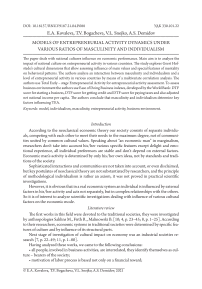Models of entrepreneurial activity dynamics under various ratios of masculinity and individualism
Автор: Kovaleva E.A., Bogacheva T.V., Snejko V.L., Demidov A.S.
Рубрика: Управление сложными системами
Статья в выпуске: 4, 2021 года.
Бесплатный доступ
The paper deals with national cultures influence on economic performance. Main aim is to analyze the impact of national culture on entrepreneurial activity in various countries. The study explores Geert Hof-stede’s cultural dimensions that allow assessing influence of main values and special features of mentality on behavioral patterns. The authors analyze an interaction between masculinity and individualism and a level of entrepreneurial activity in various countries by means of a multivariate correlation analysis. The authors use Total Early - stage Entrepreneurial Activity for entrepreneurial activity assessment. To assess business environment the authors use Ease of Doing Business indexes, developed by the World Bank: DTF score for starting a business, DTF score for getting credit and DTF score for paying taxes and also adjusted net national income per capita. The authors conclude that masculinity and individualism determine key factors influencing TEA.
Model, individualism, masculinity, entrepreneurial activity, business environment
Короткий адрес: https://sciup.org/148323538
IDR: 148323538 | DOI: 10.18137/RNU.V9187.21.04.P.088
Список литературы Models of entrepreneurial activity dynamics under various ratios of masculinity and individualism
- Adjusted net national income per capita. Date Views 3.09.2021. Available at: https://data.worldbank.org/indicator/NY.ADJ.NNTY.KD?locations=XE
- Adjusted net national income per capita. Date Views 3.09.2021. Available at: https://www.indexmundi.com/facts/indicators/NY.ADJ.NNTY.PC.KD
- Compare countries. Date Views 3.09.2021. Available at: https://www.hofstede-insights.com/product/compare-countries
- Firth, R. (1956) Human types: An introduction to social anthropology. New American Library, pp. 23-45.
- GEM Global Entrepreneurship Monitor. Date Views 3.09.2021. Available at: http://www.gemconsortium.org
- Hofstede G. (2001) Culture’s Consequences: Comparing Values, Behaviors, Institutions, and Organizations Across Nations. Second Edition, Thousand Oaks CA: Sage Publications.
- Huntington S.P., Samuel P. (2010) The Clash of Civilisations? Foreign Affairs, 72 (3), pp. 22-49.
- Malinowski B. (1922) Introduction: The subject, method and scope of the inquiry. In Argonauts of the Western Pacific. Prospect Heights, IL: Waveland Press, pp. 1-25. Available at: https://doi.org/10.2307/2548181
- Mitchell R.K., Smith B., Seawright K.W., & Morse E.A. (2010) Cross-cultural cognitions and the venture creation decision. Academy of Management Journal, 43, pp. 974-993.
- Sahlins M. (1972) Stone Age Economics. Stone Age Economics. Available at: https://doi.org/10.1525/cag.1998.20.2-3.102
- Schumacher E.F. Small is beautiful. Harsper Perennial. London, Harper Perennial, pp. 1-80. Available at: https://doi.org/10.1016/0265-9646(91)90030-L
- Shane S. (1992) Why do some societies invent more than others? Journal of Business Venturing, 7, pp. 29-46.
- Shane S. (1993) Cultural influences on national rates of innovation. Journal of Business Venturing, 8, pp. 59-73.
- Shane S. (1994) Cultural values and the championing process. Entrepreneurship Theory & Practice, 18, pp. 25-41.


